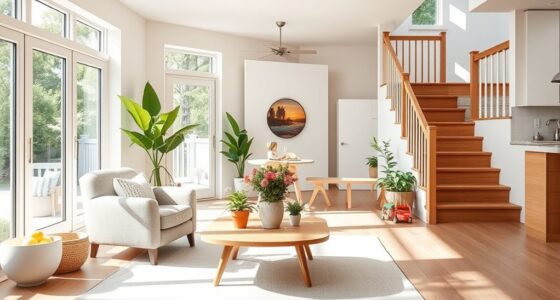Age-friendly design for senior living is evolving with smart technology and community input. You’ll see homes equipped with sensors for safety, voice-activated controls, and automated systems that reduce physical strain. Communities focus on inclusivity by involving seniors in planning and promoting social connections through events and digital platforms. These trends aim to enhance independence, safety, and quality of life. Continue exploring to discover how these innovations are shaping the future of senior living.
Key Takeaways
- Integration of smart technology like sensors and automation enhances safety, independence, and daily comfort for seniors.
- Community-driven design emphasizes inclusivity, addressing transportation, social access, and social isolation challenges.
- Intergenerational programs and digital platforms foster stronger connections and social engagement among residents.
- Holistic planning combines technology and community input to create supportive, vibrant environments tailored for aging populations.
- Future trends focus on creating adaptable, accessible spaces that promote well-being, comfort, and active aging.

Have you ever wondered how our environment can better support the aging population? As our society ages, designing spaces that accommodate seniors becomes more essential than ever. Age-friendly design isn’t just about making buildings accessible; it’s about creating environments that foster independence, safety, and well-being. A key element in this approach is leveraging smart technology. Imagine homes equipped with sensors that detect falls or monitor health conditions, alerting caregivers instantly. Smart technology can also streamline daily routines, from voice-activated lighting to automated door locks, reducing the physical strain on seniors. These innovations not only enhance safety but also promote a sense of autonomy, empowering older adults to live comfortably and confidently within their communities.
Smart technology enhances safety, independence, and comfort for seniors in age-friendly environments.
Community engagement plays a fundamental role in shaping age-friendly environments. When designing spaces, involving seniors in the planning process guarantees their needs and preferences are prioritized. This participatory approach helps identify specific barriers they face, whether it’s steering public transportation or finding social activities nearby. By actively engaging community members, urban planners and designers can develop tailored solutions that foster inclusivity. For example, creating accessible parks with benches at appropriate heights or community centers offering diverse programs encourages social interaction and reduces feelings of isolation. When seniors have a voice in their environment, they’re more likely to feel connected and valued, which is indispensable for mental and emotional health. Additionally, understanding nutritional needs can support overall well-being and help tailor services and environments to promote healthy aging.
Incorporating smart technology and community engagement into design also encourages intergenerational interactions. Technologies like shared digital platforms can facilitate communication between residents of all ages, fostering a sense of solidarity. Community engagement initiatives, such as neighborhood events or volunteer programs, further bridge generational gaps and build stronger social ties. These strategies make neighborhoods more vibrant and supportive, making it easier for seniors to stay active and involved.
Ultimately, age-friendly design that integrates smart technology and community engagement offers a forward-thinking approach to aging. It shifts the focus from merely accommodating limitations to enhancing quality of life. When environments are thoughtfully planned with these elements, seniors are more likely to thrive in familiar, welcoming spaces. As technology advances and communities become more inclusive, the future of senior living looks brighter—where independence, safety, and social connection go hand in hand. This holistic approach not only benefits older adults but enriches the entire community, creating spaces that truly serve everyone.
Frequently Asked Questions
How Does Age-Friendly Design Impact Mental Health?
Age-friendly design positively impacts your mental health by promoting social connectivity and cognitive engagement. When spaces are accessible and inviting, you’re more likely to interact with others, reducing feelings of loneliness and depression. Thoughtfully designed environments encourage activities that stimulate your mind, helping to maintain mental sharpness. By fostering a sense of community and purpose, age-friendly design supports your emotional well-being and overall mental health as you age.
What Materials Are Best for Aging-In-Place Environments?
Imagine a home where safety and sustainability walk hand in hand. You should choose materials like sustainable materials and safety-focused finishes that prioritize durability and non-toxicity. These choices not only protect your health but also guarantee longevity and ease of maintenance. By selecting eco-friendly, slip-resistant surfaces and non-slip flooring, you create a space that’s safer for everyday living while caring for the environment.
How Can Technology Enhance Age-Friendly Living Spaces?
Technology can considerably enhance your age-friendly living space by integrating a smart home system that automates lighting, temperature, and security. Use assistive devices like voice-activated controls and fall-detection sensors to increase safety and independence. These tools make daily tasks easier, reduce risks, and give you peace of mind. Embracing smart home technology transforms your environment into a safer, more convenient space tailored to your needs.
Are There Cost-Effective Strategies for Implementing Age-Friendly Features?
You might think age-friendly features are costly, but affordable modifications prove otherwise. By focusing on budget-friendly solutions like non-slip flooring, improved lighting, and simple grab bars, you can create safer, more accessible spaces without breaking the bank. Often, small changes make a big difference, and many are easy to implement, helping you enhance safety and comfort while staying within your budget.
How Do Cultural Differences Influence Age-Friendly Design Choices?
You should consider how cultural aesthetics influence age-friendly design choices, as preferences vary widely across cultures. Incorporate design adaptability to respect diverse traditions and values, ensuring spaces feel familiar and comfortable. By understanding cultural nuances, you can create environments that promote well-being and inclusivity. This approach helps you tailor features like color schemes, layouts, and materials, making senior living spaces more welcoming and functional for residents from different backgrounds.
Conclusion
As you embrace age-friendly design, you’ll open a universe of usability, comfort, and creativity. By blending bold, beautiful, and barrier-free features, you create spaces that celebrate seniors’ safety and style. This forward-thinking focus fosters flexibility, functionality, and fulfillment. So, step confidently into the future, where thoughtful trends transform traditional living, turning aging into an accessible adventure. Remember, designing for dignity today paves the path for a more inclusive, inspiring tomorrow.









